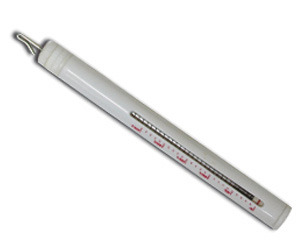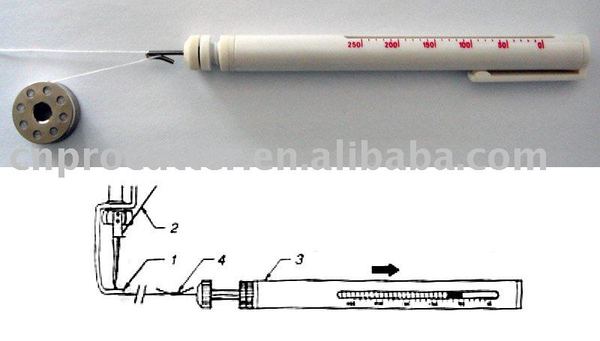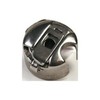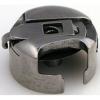This upper thread tension gauge is a great tool for finding and setting consistent thread tensions on your top threads! This thread gauge allows an embroiderer to adjust top embroidery thread tension. The Tajima thread tension gauge will work with both commercial and home embroidery machines. The thread tension gauge is hooked to the top thread from the presser foot and by pulling on the thread the embroiderer can determine the tension the embroidery machine is exerting on the thread. The embroiderer can then adjust top tension until the desired level of tension has been attained. This simple to use pen type tension gauge is suitable for both top thread and bobbin thread tension settings.
User guide settings:
- Ideal for commercial and home machines.
- Recommended tension settings for Glide Polyester thread are between 90-110 grams.
- Time Saver - no more wasting precious time trying to set tensions.
- Top Thread (Rayon 120/2 or tkt. 40) Tension Value 100-130.
- Top Thread (Polyester 60/3 or tkt. 40) Tension Value 110-150.
- Underthread (Polyester 120/2) Tension Value 20-35.
- Madeira Rayon thread usually should run between 110-125 grams.
- Madeira Polyester thread usually should run between 115-130 grams.
Tajima Thread Tension Gauge
This thread gauge allows an embroiderer to adjust top embroidery thread tension. The Tajima thread tension gauge will work with both commercial and home embroidery machines. The thread tension gauge is hooked to the top thread from the presser foot and by pulling on the thread the embroiderer can determine the tension the embroidery machine is exerting on the thread. The embroiderer can then adjust top tension until the desired level of tension has been attained. - Madeira Rayon thread usually should run between 110-125 grams. - Madeira Polyester thread usually should run between 115-130 grams.
This upper thread tension gauge is a great tool for finding and setting consistent thread tensions on your top threads!To Use This Item:
Pull 6" of thread through needle
Wrap the thread around the gauge hook
Pull the gauge towards you with the numbers facing up
As you pull, take note of the reading as this is the tension reading in grams. Polyester tension should be 120-150 grams and Rayon should be 100-120 grams.
Adjust you main tension knob until you get the correct reading.
How to Use an Upper Thread Tension Gauge
Take the guess work out of setting thread tensions.
Using thread tension gauges makes it easy to adjust both bobbin and upper tensions. It's quick, easy and will help you eliminate unsightly bobbin thread showing on top, looping top stitches and thread breaks. Your embroidery will look its best with consistent, balanced thread tensions. Here's how to use a top embroidery thread tension gauge to take the tension out of setting tensions!
Instructions for Use:
- Pull approximately 6 inches of thread through the needle and presser foot.
- Wrap the thread around the gauge hook (sometimes it's necessary to wrap it
several times so it won't slip).
- Steadily pull the gauge towards you with the window of the barrel facing up.
- As you pull, take note of the reading. These represent tension readings in grams. Polyester threads require higher tensions than Rayon. Polyester tensions 120 to 150 grams. Rayon tensions 100 to 120 grams.
- Adjust your machine main tension knob until you get the desired reading.
Once you have adjusted your thread tensions, it's always a good idea to run tests.
- First run the fill stitch test pattern.
- If you experience any top stitch looping, slowly tighten the main upper tension knob until this looping goes away (looping can also occur if your bobbin tension is too tight).
- Proper tensions for satin stitches should reveal 1/3 bobbin and 2/3 top thread color on the underside of the embroidery.
Note: Too much bobbin showing on the underside and/or showing on the topside usually means either the bobbin tension is too loose or the top thread tension is too tight
Click Here to View a Troubleshooting Guide for Thread from Superior Thread Company(.PDF)
Tajima thread tension gauge enables embroiderers to measure and adjust top thread tension on both commercial and home machines. The tension gauge is hooked to the top thread from the presser foot and by pulling on the thread the embroiderer can determine the tension the embroidery machine is exerting on the thread. The embroiderer can then adjust top tension until the desired level of embroidery thread tension has been attained.
- Madeira Rayon thread usually should run between 110-125 grams.
- Madeira Polyester thread usually should run between 115-130 grams.
How to Use an Upper Thread Tension Gauge
Take the guesswork out of setting thread tensions. Using thread tension gauges makes it easy to adjust both bobbin and upper tensions. It's quick, easy and will help you eliminate unsightly bobbin thread showing on top, looping top stitches and thread breaks. Your embroidery will look its best with consistent, balanced thread tensions. Here's how to use a top embroidery thread tension gauge to take the tension out of setting tensions!
Instructions for Use:
Pull approximately 6 inches of thread through the needle and presser foot.
Wrap the thread around the gauge hook (sometimes it's necessary to wrap it several times so it won't slip).
Steadily pull the gauge towards you with the window of the barrel facing up.
As you pull, take note of the reading. These represent tension readings in grams. Polyester threads require higher tensions than Rayon. Polyester tensions 120 to 150 grams. Rayon tensions 100 to 120 grams.
Adjust your machine main tension knob until you get the desired reading.
Once you have adjusted your thread tensions, it's always a good idea to run tests.
First run the fill stitch test pattern.
If you experience any top stitch looping, slowly tighten the main upper tension knob until this looping goes away (looping can also occur if your bobbin tension is too tight).
Proper tensions for satin stitches should reveal 1/3 bobbin and 2/3 top thread color on the underside of the embroidery.
Note: Too much bobbin showing on the underside and/or showing on the topside usually means either the bobbin tension is too loose or the top thread tension is too tight
Common Singer Bobbin Cases & Bobbin Case Tension: Sunday Morning Quickies September 19, 2021 by Bob Fowler
I love your company and will order almost exclusively from your company if you offer the items I am in need of.. Thank you for speedy shipment. Shirley
Daniel H, Gladwin MI
will order again from you
Maso J, Polson MT
After my interaction with your staff, Allbrands is the first place I go to look for embroidery supplies. .
Karen H, Moncks Corner SC
I was extremely pleased with the speed of full filling my order. It arrived just a few days after I placed my order. I will order from you again.

















